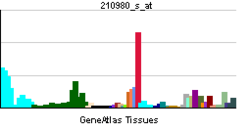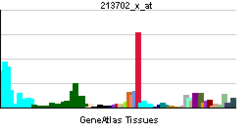ASAH1
Acid ceramidase is an enzyme that in humans is encoded by the ASAH1 gene.[3][4][5]
This gene encodes a heterodimeric protein consisting of a nonglycosylated alpha subunit and a glycosylated beta subunit that is cleaved to the mature enzyme posttranslationally. The encoded protein catalyzes the synthesis and degradation of ceramide into sphingosine and fatty acid. Mutations in this gene have been associated with a lysosomal storage disorder known as Farber disease and, recently, with a rare neurodegenerative condition known as spinal muscular atrophy with progressive myoclonic epilepsy.[6] Two transcript variants encoding distinct isoforms have been identified for this gene.[5] In melanocytic cells ASAH1 gene expression may be regulated by MITF.[7]
References
- ↑ "Human PubMed Reference:".
- ↑ "Mouse PubMed Reference:".
- ↑ Koch J, Gartner S, Li CM, Quintern LE, Bernardo K, Levran O, Schnabel D, Desnick RJ, Schuchman EH, Sandhoff K (Jan 1997). "Molecular cloning and characterization of a full-length complementary DNA encoding human acid ceramidase. Identification Of the first molecular lesion causing Farber disease". J Biol Chem. 271 (51): 33110–5. doi:10.1074/jbc.271.51.33110. PMID 8955159.
- ↑ Li CM, Park JH, He X, Levy B, Chen F, Arai K, Adler DA, Disteche CM, Koch J, Sandhoff K, Schuchman EH (Feb 2000). "The human acid ceramidase gene (ASAH): structure, chromosomal location, mutation analysis, and expression". Genomics. 62 (2): 223–31. doi:10.1006/geno.1999.5940. PMID 10610716.
- 1 2 "Entrez Gene: ASAH1 N-acylsphingosine amidohydrolase (acid ceramidase) 1".
- ↑ Zhou, J.; Tawk, M.; Tiziano, F. D.; Veillet, J.; Bayes, M.; Nolent, F.; Garcia, V.; Servidei, S.; Bertini, E.; Castro-Giner, F.; Renda, Y.; Carpentier, S. P.; Andrieu-Abadie, N.; Gut, I.; Levade, T.; Topaloglu, H.; Melki, J. (2012). "Spinal Muscular Atrophy Associated with Progressive Myoclonic Epilepsy is Caused by Mutations in ASAH1". The American Journal of Human Genetics. 91 (1): 5–14. doi:10.1016/j.ajhg.2012.05.001. PMC 3397266
 . PMID 22703880.
. PMID 22703880. - ↑ Hoek KS, Schlegel NC, Eichhoff OM, et al. (2008). "Novel MITF targets identified using a two-step DNA microarray strategy". Pigment Cell Melanoma Res. 21 (6): 665–76. doi:10.1111/j.1755-148X.2008.00505.x. PMID 19067971.
Further reading
- Perry DK, Hannun YA (1999). "The role of ceramide in cell signaling.". Biochim. Biophys. Acta. 1436 (1-2): 233–43. doi:10.1016/S0005-2760(98)00145-3. PMID 9838138.
- Bernardo K, Hurwitz R, Zenk T, et al. (1995). "Purification, characterization, and biosynthesis of human acid ceramidase.". J. Biol. Chem. 270 (19): 11098–102. doi:10.1074/jbc.270.19.11098. PMID 7744740.
- Maruyama K, Sugano S (1994). "Oligo-capping: a simple method to replace the cap structure of eukaryotic mRNAs with oligoribonucleotides.". Gene. 138 (1-2): 171–4. doi:10.1016/0378-1119(94)90802-8. PMID 8125298.
- Suzuki Y, Yoshitomo-Nakagawa K, Maruyama K, et al. (1997). "Construction and characterization of a full length-enriched and a 5'-end-enriched cDNA library.". Gene. 200 (1-2): 149–56. doi:10.1016/S0378-1119(97)00411-3. PMID 9373149.
- Seelan RS, Qian C, Yokomizo A, et al. (2000). "Human acid ceramidase is overexpressed but not mutated in prostate cancer.". Genes Chromosomes Cancer. 29 (2): 137–46. doi:10.1002/1098-2264(2000)9999:9999<::AID-GCC1018>3.0.CO;2-E. PMID 10959093.
- Strelow A, Bernardo K, Adam-Klages S, et al. (2000). "Overexpression of acid ceramidase protects from tumor necrosis factor-induced cell death.". J. Exp. Med. 192 (5): 601–12. doi:10.1084/jem.192.5.601. PMC 2193270
 . PMID 10974027.
. PMID 10974027.
- Bär J, Linke T, Ferlinz K, et al. (2001). "Molecular analysis of acid ceramidase deficiency in patients with Farber disease.". Hum. Mutat. 17 (3): 199–209. doi:10.1002/humu.5. PMID 11241842.
- Ferlinz K, Kopal G, Bernardo K, et al. (2001). "Human acid ceramidase: processing, glycosylation, and lysosomal targeting.". J. Biol. Chem. 276 (38): 35352–60. doi:10.1074/jbc.M103066200. PMID 11451951.
- Strausberg RL, Feingold EA, Grouse LH, et al. (2003). "Generation and initial analysis of more than 15,000 full-length human and mouse cDNA sequences.". Proc. Natl. Acad. Sci. U.S.A. 99 (26): 16899–903. doi:10.1073/pnas.242603899. PMC 139241
 . PMID 12477932.
. PMID 12477932.
- Muramatsu T, Sakai N, Yanagihara I, et al. (2003). "Mutation analysis of the acid ceramidase gene in Japanese patients with Farber disease.". J. Inherit. Metab. Dis. 25 (7): 585–92. doi:10.1023/A:1022047408477. PMID 12638942.
- Zhang H, Li XJ, Martin DB, Aebersold R (2003). "Identification and quantification of N-linked glycoproteins using hydrazide chemistry, stable isotope labeling and mass spectrometry.". Nat. Biotechnol. 21 (6): 660–6. doi:10.1038/nbt827. PMID 12754519.
- Okino N, He X, Gatt S, et al. (2003). "The reverse activity of human acid ceramidase.". J. Biol. Chem. 278 (32): 29948–53. doi:10.1074/jbc.M303310200. PMID 12764132.
- He X, Okino N, Dhami R, et al. (2003). "Purification and characterization of recombinant, human acid ceramidase. Catalytic reactions and interactions with acid sphingomyelinase.". J. Biol. Chem. 278 (35): 32978–86. doi:10.1074/jbc.M301936200. PMID 12815059.
- Ota T, Suzuki Y, Nishikawa T, et al. (2004). "Complete sequencing and characterization of 21,243 full-length human cDNAs.". Nat. Genet. 36 (1): 40–5. doi:10.1038/ng1285. PMID 14702039.
- Hara S, Nakashima S, Kiyono T, et al. (2005). "p53-Independent ceramide formation in human glioma cells during gamma-radiation-induced apoptosis.". Cell Death Differ. 11 (8): 853–61. doi:10.1038/sj.cdd.4401428. PMID 15088070.
- Gerhard DS, Wagner L, Feingold EA, et al. (2004). "The status, quality, and expansion of the NIH full-length cDNA project: the Mammalian Gene Collection (MGC).". Genome Res. 14 (10B): 2121–7. doi:10.1101/gr.2596504. PMC 528928
 . PMID 15489334.
. PMID 15489334.
- Lewandrowski U, Moebius J, Walter U, Sickmann A (2006). "Elucidation of N-glycosylation sites on human platelet proteins: a glycoproteomic approach.". Mol. Cell Proteomics. 5 (2): 226–33. doi:10.1074/mcp.M500324-MCP200. PMID 16263699.


 . PMID 22703880.
. PMID 22703880. . PMID 10974027.
. PMID 10974027. . PMID 12477932.
. PMID 12477932. . PMID 15489334.
. PMID 15489334.